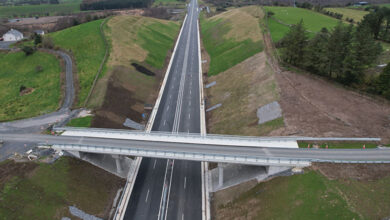Managing flood risks
Eoin O’Neill discusses the behavioural dimensions that will need to be considered in order to equip the nation with the necessary resources to combat future flooding.
 Ireland has experienced a series of damaging storm and flood episodes in recent years. Up to now the resultant costs have been manageable. However, with climate change resulting in a rising sea-level and more intense storms and flooding, the future projected costs will place a much larger burden on Irish society. We have to start to prepare people for the challenge of coping with these changes and adapt our built environment.
Ireland has experienced a series of damaging storm and flood episodes in recent years. Up to now the resultant costs have been manageable. However, with climate change resulting in a rising sea-level and more intense storms and flooding, the future projected costs will place a much larger burden on Irish society. We have to start to prepare people for the challenge of coping with these changes and adapt our built environment.
Preparing for change is a big challenge when there is little engagement or public debate about the nature of the adaptation choices that we face, yet these changes must be implemented within a single generation. Even with the prolonged flooding experienced in many parts this past winter, climate-related concerns and flood management did not have a particularly high national profile during the general election campaign. This may have arisen because, for many of the electorate, climate change is somewhat intangible and perhaps not perceived as something that will affect their daily lives. Aspects of climate (mitigation) policy are starting to permeate people’s lives but in most respects, climate concerns remain something distant for many.
Risk factors
Given its lower political priority, apart from during periods of adverse flooding, it is fortunate that the EU Floods Directive has forced all European states, including Ireland, to undertake comprehensive national analysis of their current and long-term exposure to flood risk and to make integrated plans to manage those risks at catchment scales. Risk is viewed by the directive as being concerned with the likelihood (or probability) and adverse impacts (or consequences) of flood events. Consequently, combinations of measures to address both components of risk are required, making provision for: prevention through better spatial planning; protection through structural defences and approaches that replicate natural processes such as floodplain restoration; and preparedness through flood forecasting and flood warning, awareness-raising, co-ordination of critical service providers and community action. By implementing these types of measures, it is possible to reduce risk overall although it cannot be totally removed.
In an Irish context the Office of Public Works has published flood risk maps covering river catchments in line with the Directive. Building on this knowledge, options to manage flooding across 300 areas at significant risk are being considered as part of the process to finalise Flood Risk Management plans. In the run up to the general election, government communications about increasing flood-related expenditure to €430 million (for the period 2016 to 2021) to implement these plans strongly focused on flood defence elements. Yet where defences are not viable, there are other approaches available. These include schemes that combine flood warnings with promotion of household resilience measures to increase preparedness.
Whilst the increase in expenditure to deliver these measures is welcome, it is not clear that Irish society is fully engaged with how the management of flooding is being developed for them. The public opposition to the perceived loss of amenity from the construction of coastal flood defences at Clontarf seafront is symbolic of other as yet unidentified risk-benefit trade-off conflicts. It is important that a public debate takes place about the nature of society’s climate and flood adaptation choices so that people understand their implications.
One of the challenges associated with constructing large-scale flood defence infrastructure is that it often produces two somewhat undesirable consequences. Firstly, it often results in an intensification of development behind defences, thereby increasing the number of people vulnerable to a more catastrophic flood event, known in the US as the ‘levee effect.’ Secondly, by reducing people’s exposure to more frequent and moderate flooding events that communities were forced to confront, it reduces their ability to be resilient to, and cope with, events that are larger and that will overwhelm the standard of protection provided by defences.
Therefore, whilst defences are frequently necessary and more will be built, we also need to change the nature of the relationship between people and flood waters, especially in the urban environment. In the long-run, parts of the defended floodplain can be redesigned with public and private spaces rededicated for flood storage and integrated into the design of new developments to replicate natural processes, like the case of HafenCity in Hamburg. Complementary to capital investment, we also need to invest more in the social capacity of communities to increase their levels of preparedness, and to resource climate-related social-science expertise. This is necessary for us to understand the interface where physical systems interact with people in the urbanised environment. This interface can be mediated through behaviour change communications, and improved understanding of the dynamics of human behaviour including evacuation and household actions.
Perception of risk
One of the advantages of large-scale structural defences is that there is little requirement for co-ordination of people up to the standard of protection that it provides. But, where those defences are overwhelmed or where there are no defences, there are significant behavioural responses and co-ordinated action that is required to minimise the consequence of flooding. A number of issues need greater consideration.
How will people respond to flood warnings? Will people believe what they hear? What is the best mechanism to deliver flood warnings? Does it matter who delivers flood warnings or evacuation instructions? What types of non-physical barriers exist to people evacuating their homes? What types of non-physical barriers exist to people implementing household protection measures? What is the best way to co-ordinate critical services providers and community action?
Some of these factors can be better explained if we understand how people perceive risk; a factor that influences preparedness. Related case study research I recently conducted with colleagues in UCD generated some interesting results. We found that people often misperceive the flood risk to which they are exposed, reporting that they are not located within a flood zone (when they are) or reporting that they are further away from the flood zone than they actually are. Although we found previous flood experience to be the best predictor of preparedness actions or intent, these finding also help to explain the low levels of preparedness we found among at-risk participants. These results highlight the need to continuously invest in awareness-raising in both defended and undefended communities.
It is evident therefore that we need more social-science research and expertise in place to help inform decision-making and plan implementation. The recent public policy experience with Irish Water is demonstrative that policy decisions need to be carefully considered and the behavioural response of people is critical to policy success. Just as the state is committing significant expenditure to understand the behavioural dynamics of floodwater, we equally need to commit funding to understand the behavioural dynamics of people as they interact with floodwater. It is after all the impacts of flood hazards on people that is of utmost concern.
Eoin O’Neill is a lecturer in Environmental Policy at University College Dublin.





